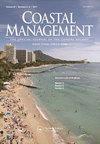海岸线保护的成本:新英格兰沿海地区与大西洋中部地区的比较
IF 1.9
4区 环境科学与生态学
Q4 ENVIRONMENTAL SCIENCES
引用次数: 1
摘要
海岸线硬化是一种海岸灾害保护方法,通常由政府机构和个人财产所有者实施。随着人们越来越认识到海岸线硬化的潜在负面影响,自然和基于自然的方法越来越受欢迎。大多数与海岸线保护有关的研究都集中在了解环境和生态影响上。然而,特别是对于基于自然的混合方法,可用于比较其货币成本的信息有限。为了填补这一空白,本研究使用了从新英格兰和大西洋中部地区的公共海岸线保护项目中收集的信息,根据所使用的材料,如植被、沙子和/或石头,估计了这些措施的成本。这种方法可以详细衡量潜在的项目投入,并提供当地政府和其他利益相关者在海岸线保护方法中可能使用的材料类型所需的成本信息。结果表明,使用天然材料的方法往往比使用更传统的工程材料的方法成本更低,而基于自然的方法往往介于两者之间。具体而言,根据项目的平均单位成本,项目可分为四个子组:(A)墙壁(平均:5628美元,se:680美元)或裸露场地的石头(平均:4943美元,se:725美元);(B) 用于海滩营养的沙子(平均:3094美元,se:397美元)或低暴露地点的石头(3014美元,se:379美元);(C) 低暴露地点的石头和植被(平均:1626美元,se:217美元),低暴露地点用于其他目的的石头和沙子(平均:1411美元,se:173美元),或用于其他目的(平均:1384美元,se=151美元);以及(D)低暴露地点的其他用途的石头和沙子(平均:1411美元,se:173美元)、其他用途的沙子(平均值:1384美元,se:151美元)、植被(平均值为1300美元,se=159美元)或其他用途的植被和沙子(均数为1285美元,se/172美元)。最后,监测和维护费用往往没有得到考虑,这可能对海岸线保护工作的长期成功产生负面影响。再加上关于这些不同方法的环境和生态影响的信息,这些信息将使人们能够就沿海和内陆社区如何最好地适应沿海风险做出更明智的决定。本文章由计算机程序翻译,如有差异,请以英文原文为准。
The Cost of Shoreline Protection: A Comparison of Approaches in Coastal New England and the Mid-Atlantic
Abstract Shoreline hardening is a method of coastal hazard protection that is often implemented by government agencies and individual property owners. As awareness of the potential negative effects of shoreline hardening has increased, natural and nature-based approaches have gained in popularity. Most research related to shoreline protection has focused on understanding the environmental and ecological effects. However, for hybrid, nature-based approaches, in particular, there is limited information available to compare their monetary costs. To fill this gap, this study used information collected from public shoreline protection projects within the New England and Mid-Atlantic areas to estimate the costs of these measures based on the materials used, such as vegetation, sand, and/or stone. This approach allows for a detailed measurement of potential project inputs and provides needed cost information on the types of materials local governments and other stakeholders may use in their shoreline protection approaches. Results suggest that approaches that use natural materials tend to cost less than those that use more traditional, engineered materials, and nature-based approaches tend to cost somewhere in-between. Specifically, projects can be divided into four subgroups based on their average per-unit costs: (A) walls (mean: $5,628, se: $680) or stone at exposed sites (mean: $4,943, se: $725); (B) sand for beach nourishment (mean: $3,094, se: $397) or stone at low exposure sites ($3,014, se: $379); (C) stone and vegetation at low exposure sites (mean: $1,626, se: $217), stone and sand for other purposes at low exposure sites (mean: $1,411, se: $173), or sand for other purposes (mean: $1,384, se: $151); and (D) stone and sand for other purposes at low exposure sites (mean: $1,411, se: $173), sand for other purposes (mean: $1,384, se: $151), vegetation (mean: $1,300, se: $159), or vegetation and sand for other purposes (mean: $1,285, se: $172). Finally, monitoring and maintenance costs are often not accounted for, which may negatively affect the long-term success of shoreline protection efforts. Coupled with information on environmental and ecological effects of these different approaches, this information will allow for more informed decisions on how coastal and inland communities can best adapt to coastal risks.
求助全文
通过发布文献求助,成功后即可免费获取论文全文。
去求助
来源期刊

Coastal Management
环境科学-环境科学
CiteScore
6.00
自引率
0.00%
发文量
24
审稿时长
>36 weeks
期刊介绍:
Coastal Management is an international peer-reviewed, applied research journal dedicated to exploring the technical, applied ecological, legal, political, social, and policy issues relating to the use of coastal and ocean resources and environments on a global scale. The journal presents timely information on management tools and techniques as well as recent findings from research and analysis that bear directly on management and policy. Findings must be grounded in the current peer reviewed literature and relevant studies. Articles must contain a clear and relevant management component. Preference is given to studies of interest to an international readership, but case studies are accepted if conclusions are derived from acceptable evaluative methods, reference to comparable cases, and related to peer reviewed studies.
 求助内容:
求助内容: 应助结果提醒方式:
应助结果提醒方式:


